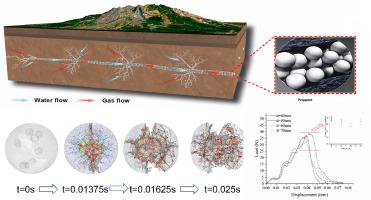当前位置:
X-MOL 学术
›
J. Mater. Sci. Technol.
›
论文详情
Our official English website, www.x-mol.net, welcomes your feedback! (Note: you will need to create a separate account there.)
Revelling pore microstructure impacts on the compressive strength of porous proppant based on finite and discrete element method
Journal of Materials Science & Technology ( IF 11.2 ) Pub Date : 2024-06-18 , DOI: 10.1016/j.jmst.2024.05.054 Zijia Liao , Hesamoddin Rabiee , Lei Ge , Xiaogang Li , Zhaozhong Yang , Qi Xue , Chao Shen , Hao Wang
Journal of Materials Science & Technology ( IF 11.2 ) Pub Date : 2024-06-18 , DOI: 10.1016/j.jmst.2024.05.054 Zijia Liao , Hesamoddin Rabiee , Lei Ge , Xiaogang Li , Zhaozhong Yang , Qi Xue , Chao Shen , Hao Wang

|
Ceramic spheres, typically with a particle diameter of less than 0.8 mm, are frequently utilized as a critical proppant material in hydraulic fracturing for petroleum and natural gas extraction. Porous ceramic spheres with artificial inherent pores are an important type of lightweight proppant, enabling their transport to distant fracture extremities and enhancing fracture conductivity. However, the focus frequently gravitates towards the low-density advantage, often overlooking the pore geometry impacts on compressive strength by traditional strength evaluation. This paper numerically bypasses such limitations by using a combined finite and discrete element method (FDEM) considering experimental results. The mesh size of the model undergoes validation, followed by the calibration of cohesive element parameters via the single particle compression test. The stimulation elucidates that proppants with a smaller pore size (40 µm) manifest crack propagation evolution at a more rapid pace in comparison to their larger-pore counterparts, though the influence of pore diameter on overall strength is subtle. The inception of pores not only alters the trajectory of crack progression but also, with an increase in porosity, leads to a discernible decline in proppant compressive strength. Intriguingly, upon crossing a porosity threshold of 10 %, the decrement in strength becomes more gradual. A denser congregation of pores accelerates crack propagation, undermining proppant robustness, suggesting that under analogous conditions, hollow proppants might not match the strength of their porous counterparts. This exploration elucidates the underlying mechanisms of proppant failure from a microstructural perspective, furnishing pivotal insights that may guide future refinements in the architectural design of porous proppant.
中文翻译:

基于有限离散元法揭示孔隙微观结构对多孔支撑剂抗压强度的影响
陶瓷球的粒径通常小于 0.8 毫米,经常用作石油和天然气开采水力压裂中的关键支撑剂材料。具有人工固有孔隙的多孔陶瓷球是一种重要的轻质支撑剂,使其能够输送到远处的裂缝末端并增强裂缝导流能力。然而,焦点经常倾向于低密度优势,常常忽视传统强度评估中孔隙几何形状对抗压强度的影响。考虑到实验结果,本文通过使用组合有限元和离散元方法(FDEM)在数值上绕过了这些限制。模型的网格尺寸经过验证,然后通过单颗粒压缩测试校准粘性单元参数。刺激表明,与较大孔径的支撑剂相比,较小孔径 (40 µm) 的支撑剂表现出裂纹扩展演化速度更快,尽管孔径对整体强度的影响很微妙。孔隙的产生不仅改变了裂缝进展的轨迹,而且随着孔隙率的增加,导致支撑剂抗压强度明显下降。有趣的是,当孔隙率阈值超过 10% 时,强度的下降变得更加缓慢。更密集的孔隙聚集会加速裂纹扩展,破坏支撑剂的坚固性,这表明在类似条件下,空心支撑剂的强度可能无法与多孔支撑剂的强度相匹配。 这项探索从微观结构的角度阐明了支撑剂失效的根本机制,提供了可能指导未来多孔支撑剂结构设计改进的关键见解。
更新日期:2024-06-18
中文翻译:

基于有限离散元法揭示孔隙微观结构对多孔支撑剂抗压强度的影响
陶瓷球的粒径通常小于 0.8 毫米,经常用作石油和天然气开采水力压裂中的关键支撑剂材料。具有人工固有孔隙的多孔陶瓷球是一种重要的轻质支撑剂,使其能够输送到远处的裂缝末端并增强裂缝导流能力。然而,焦点经常倾向于低密度优势,常常忽视传统强度评估中孔隙几何形状对抗压强度的影响。考虑到实验结果,本文通过使用组合有限元和离散元方法(FDEM)在数值上绕过了这些限制。模型的网格尺寸经过验证,然后通过单颗粒压缩测试校准粘性单元参数。刺激表明,与较大孔径的支撑剂相比,较小孔径 (40 µm) 的支撑剂表现出裂纹扩展演化速度更快,尽管孔径对整体强度的影响很微妙。孔隙的产生不仅改变了裂缝进展的轨迹,而且随着孔隙率的增加,导致支撑剂抗压强度明显下降。有趣的是,当孔隙率阈值超过 10% 时,强度的下降变得更加缓慢。更密集的孔隙聚集会加速裂纹扩展,破坏支撑剂的坚固性,这表明在类似条件下,空心支撑剂的强度可能无法与多孔支撑剂的强度相匹配。 这项探索从微观结构的角度阐明了支撑剂失效的根本机制,提供了可能指导未来多孔支撑剂结构设计改进的关键见解。
















































 京公网安备 11010802027423号
京公网安备 11010802027423号